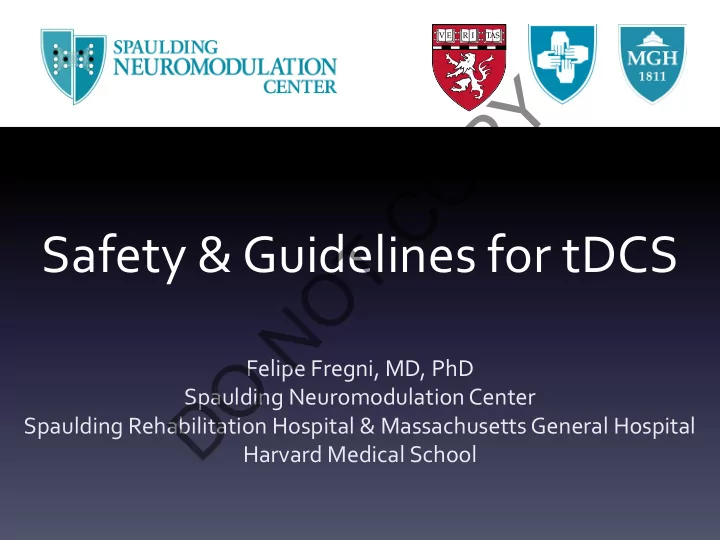

Y P O C T Safety & Guidelines for tDCS O N O Felipe Fregni, MD, PhD D Spaulding Neuromodulation Center Spaulding Rehabilitation Hospital & Massachusetts General Hospital Harvard Medical School
Y P O C T O N O D
Is tDCS Safe? Y P O C T O N O D The FDA has not approved tDCS as a therapy or approved ANY device for tDCS.
Y P O C T Risks to Subjects O N O D
Theoretical Risks (1): skin Y P • Potential Effects O C – Electrolysis, Permeability Changes, Increased Metabolic Activity, Seizure? T • Burn O • Stimulating subjects with: N – Reduced Sensation O – Broken Skin D – Conductive Implants – Tumor – Concurrent Pharmacological Treatments
Tissue heating Y P O • Animal study – C T Liebetanz et al, 2009 O N O D
Skin burn/dermatitis Y P O Skin lesion: C “The anodal electrode was T fixed by an O EEG cap. Two mA stimulation N current was applied for 26 min, including O 30 s ramp in D and 30 s ramp out.” Healthy subject – single session (Wang, 2015)
Skin lesion (2) Y P O C Patient – several sessions (4/5) – 1mA T over 20 minutes. O (Palm, 2008) N O D
Contact dermatitis Y P O Healthy subject: C Single session, symptoms appeared after 24 hs of T stimulation and got worse. (Kaubish, 2012) O N O D
Y P O How about if a subject has C T a skull defect? O N O D
Current Distribution in tDCS Y P O C T O N O D Datta et. al., 2009 • Wagner et al., 2007 •
Skull Y defect P O C T O N O D
Y P O C T O N O D Datta, 2010
Y P O C T Other Adverse Effects O N O D
Adverse Effect Reports Y P • Brunoni et al., 2011 – Systematically reviewed O reports of AE ’ s in human studies of patients and healthy subjects. C – 172 articles (209 studies) included T – 117 studies assessed AE ’ s O – 74 studies reported at least 1 AE • Findings for Active Stimulation: N – Most commonly reported effects are mild O – Itching (39.3%) – Tingling (22.2%) D – Headache (14.8%) – Burning sensation (8.7%) – Discomfort (10.4%)
Y P O C T Device O N O D
Device Safety Features Y P • Automatic Current Ramping O • Impedance Check C • Display of Actual Current T O • Soterix Medical Device N – SMARTscan – “ Relax ” Slider O – “ Tickle ” Button D – Low Battery Light
Cables Y P O C T O N O D
Practical Safety Considerations Y P • Hair O • Excess Water Run-off C • Old/Dried out sponges T • Broken Electrodes O • Rusting of Equipment N • Battery Charge O • Current Fluctuation During Stimulation D • Current Spiking During Device On/Off
Safety Recommendations Y P O • Screening for exclusion criteria C • Keep informed of new safety guidelines T • Consider specific device O • Obtain IRB approval N • Consider environment for stimulation (ex. O D Hospital/University) • Have emergency procedures prepared
Y P O C T O N Thank You O D
Recommend
More recommend